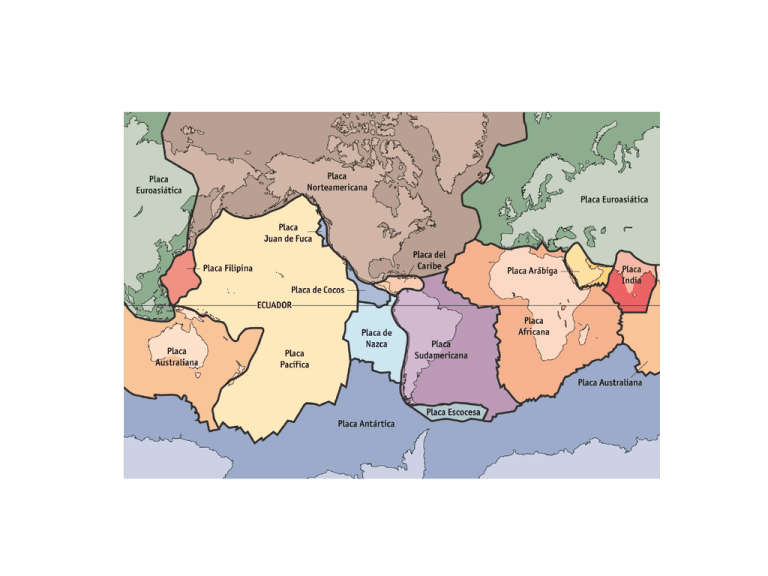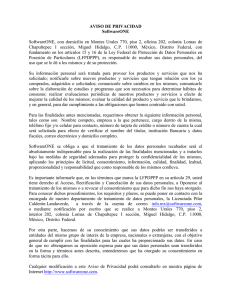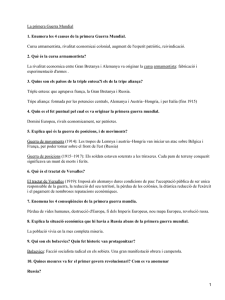MAPA FISICO DE RUSIA
Anuncio

MAPA FISICO DE RUSIA OROGRAFIA • Broad plain with low hills west of Urals; vast coniferous forest and tundra in Siberia; uplands and mountains along southern border regions. • Elevation extremes: • lowest point: Caspian Sea -28 m • highest point: Gora El'brus 5,633 m • SISMICIDAD 1990 - 2002 URALES INTRODUCCIÓN • The Ural Mountains, which extend more than 2,200 kilometers from north to south, form the boundary separating the unequal European and Asian sectors of Russia. The continental divide continues another 1,375 kilometers from the southern end of the Ural Mountains through the Caspian Sea and along the Caucasus Mountains. RUSIA RIOS • Russia is a water-rich country. The earliest settlements in the country sprang up along the rivers, where most of the urban population continues to live. • The Volga, Europe's longest river, is by far Russia's most important commercial waterway. Four of the country's thirteen largest cities are located on its banks: Nizhniy Novgorod, Samara, Kazan', and Volgograd. • The Kama River, which flows west from the southern Urals to join the Volga in the Republic of Tatarstan, is a second key European water system whose banks are densely populated RUSIA RIOS • Russia has thousands of rivers and inland bodies of water, providing it with one of the world's largest surface-water resources. However, most of Russia's rivers and streams belong to the Arctic drainage basin, which lies mainly in Siberia but also includes part of European Russia. • Altogether, 84 percent of Russia's surface water is located east of the Urals in rivers flowing through sparsely populated territory and into the Arctic and Pacific oceans. In contrast, areas with the highest concentrations of population, and therefore the highest demand for water supplies, tend to have the warmest climates and highest rates of evaporation. • As a result, densely populated areas such as the Don and Kuban' river basins north of the Caucasus have barely adequate (or in some cases inadequate) water resources. RUSIA RIOS • Forty of Russia's rivers longer than 1,000 kilometers are east of the Urals, including the three major rivers that drain Siberia as they flow northward to the Arctic Ocean: the Irtysh-Ob' system (totaling 5,380 kilometers), the Yenisey (4,000 kilometers), and the Lena (3,630 kilometers). • The basins of those river systems cover about 8 million square kilometers, discharging nearly 50,000 cubic meters of water per second into the Arctic Ocean. • The northward flow of these rivers means that source areas thaw before the areas downstream, creating vast swamps such as the 48,000-square-kilometer Vasyugane Swamp in the center of the West Siberian Plain. The same is true of other river systems, including the Pechora and the North Dvina in Europe and the Kolyma and the Indigirka in Siberia. Approximately 10 percent of Russian territory is classified as swampland. RUSIA RIOS • A number of other rivers drain Siberia from eastern mountain ranges into the Pacific Ocean. The Amur River and its main tributary, the Ussuri, form a long stretch of the winding boundary between Russia and China. The Amur system drains most of southeastern Siberia. Three basins drain European Russia. • The Dnepr, which flows mainly through Belarus and Ukraine, has its headwaters in the hills west of Moscow. The 1,860-kilometer Don originates in the Central Russian Upland south of Moscow and then flows into the Sea of Azov and the Black Sea at Rostov-na-Donu. • The Volga is the third and by far the largest of the European systems, rising in the Valday Hills west of Moscow and meandering southeastward for 3,510 kilometers before emptying into the Caspian Sea. Altogether, the Volga system drains about 1.4 million square kilometers. Linked by several canals, European Russia's rivers long have been a vital transportation system; the Volga system still carries two-thirds of Russia's inland water traffic . RUSIA LAGOS Y EMBALSES • Russia's inland bodies of water are chiefly a legacy of extensive glaciation. In European Russia, the largest lakes are Ladoga and Onega northeast of St. Petersburg, Lake Peipus on the Estonian border, and the Rybinsk Reservoir north of Moscow. Smaller manmade reservoirs, 160 to 320 kilometers long, are on the Don, the Kama, and the Volga rivers. • Many large reservoirs also have been constructed on the Siberian rivers; the Bratsk Reservoir northwest of Lake Baikal is one of the world's largest. URALES RIO URAL FERROCARRIL TRANSIBERIANO NORTE DE LOS URALES LOS URALES • • • • • • • Se extienden de N a S a lo largo de 3.000 Km. formando un límite oriental de la Plataforma Rusa La altitud media de los Urales es de 1.000 a 1.300 m. El pico más alto es el Narodnaya, en la región orográfica de Pripolyarnyy Ural, con 1884 m. El extremo Norte llega hasta el Océano Glaciar Ártico El Extremo Sur al inicio de la depresión del mar Caspio Al Oeste la Plataforma rusa, cuenca del Volga Al Este la Llanura siberiana, cuenca del Obi LOS URALES • • • • • • Durante el Mesozoico la cordillera fue arrasada por la erosión formándose depresiones que se colmataron con sedimentos. Luego el relieve se rejuveneció durante el terciario, mediante la elevación de los bloques sedimentarios y cristalinos o metamórficos más antiguos. Los movimientos de bloques más importantes acaecieron en las áreas centrales y orientales Se evidencian por los profundos valles, algunos de varios centenares de metros de profundidad. Los movimientos tectónicos continuaron en inicios del cuaternario, debido a la desaparición de los casquetes glaciares. LOS URALES • • • • • • LA HISTORIA GEOLÓGICA ES COMPLEJA Existió en la época precámbrica un geosinclinal denominado Proto Ural Existió una orogenia denominada Baikalian, responsable de la estructura básica de los Urales La orogenia Caledoniana no le afectó, sirviendo apenas para fortalecer su propia estructura La orogenia clave fue la herciniana que originó el plegamiento de los sedimentos y restos de la orogenia Baikalian LOS URALES • • • • Los Urales son divisoria de aguas; al Oeste los ríos de la Plataforma Rusa, al Este la Llanura Siberiana La vertiente occidental aporta sus aguas a la cuenca del Volga. El río Kama es uno de los más importantes y es afluente del Volga en su margen izquierda. La vertiente oriental drena hacia la cuenca del río Obi, que desemboca en el Ártico El río Ural es una excepción, pues nace la parte oriental, meridional de los Urales y desagua al Oeste, en el Mar Caspio RUSIA. LAGOS Y EMBALSES • The most prominent of Russia's bodies of fresh water is Lake Baikal, the world's deepest and most capacious freshwater lake. Lake Baikal alone holds 85 percent of the freshwater resources of the lakes in Russia and 20 percent of the world's total. It extends 632 kilometers in length and fifty-nine kilometers across at its widest point. Its maximum depth is 1,713 meters. • Numerous smaller lakes dot the northern regions of the European and Siberian plains. The largest of these are lakes Beloye, Topozero, Vyg, and Il'men' in the European northwest and Lake Chany in southwestern Siberia. LOS URALES • • • • • • Están basculados hacia el Este, de manera que las pendientes son mayores en ese lado que en el Oeste La larga extensión N/S que supone 22º de latitud, implieca regiones climáticas muy diferentes, por lo que la acción erosiva del hielo ha actuado en forma diferencial en las diversas secciones de la cordillera. En el Norte la acción glaciar fue notoria, dando origen a circos glaciares En la parte meridional, se mantienen formas propias de la erosión de sistemas áridos. Cortada por numerosas fallas tectónicas, que permiten diferenciar hasta siete regiones montañosas diferentes. Esta es otra de las características destacadas DOLINAS EN LOS URALES DOLINAS URALES CHEYABINSK SUR DE LOS URALES CHELYABINSK SUR URALES

